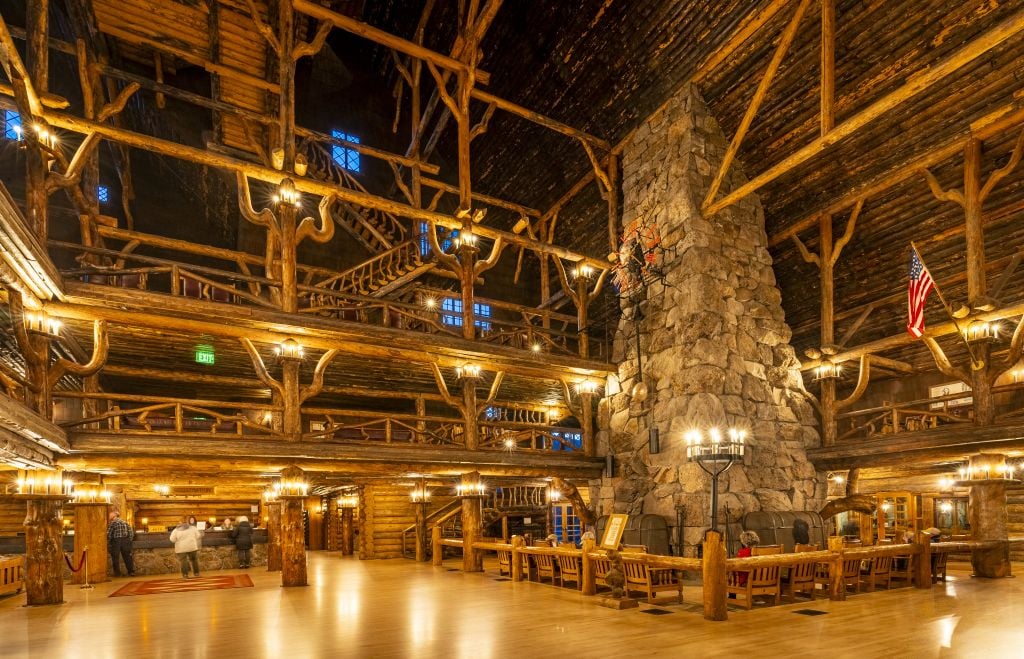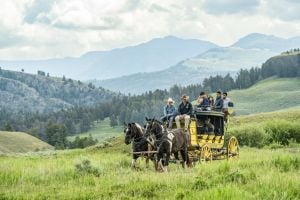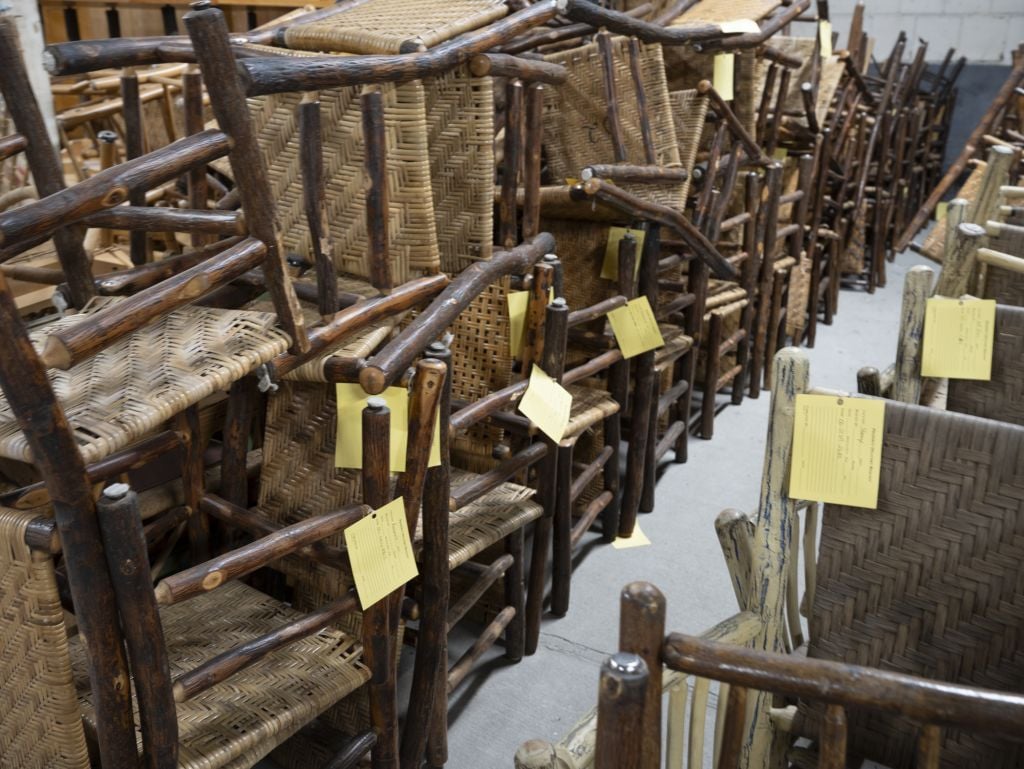Keeping Yellowstone’s History Alive Through Thoughtful Preservation
You can find many things in the Old Faithful Inn — an 85-foot-tall stone fireplace, 329 rooms, clawfoot bathtubs — but you should not find a Phillips-head screw.

Reviving the Charm of Historic Buildings
The iconic inn, believed to be one of the largest log structures in the world, was built in 1903-1904; Phillips-head screws weren’t invented until 1932. Of course, the Old Faithful Inn has gone through a number of repairs and renovations in the 120 years since it welcomed its first guests, but a goal of the Historic Preservation Crew (HPC) is to ensure that all maintenance done on historic structures uses materials representative of the era in which the structure was originally built. “Even though likely unnoticeable, Phillips-head screws would be out of place for repairs in Old Faithful Inn,” says Darren Kisor, who joined the Historic Preservation Crew in 1994 and has been the manager since 2007. The HPC falls under the umbrella of the Xanterra Travel Collection, which manages the lodges in Yellowstone National Park.
Founded in 1993, the HPC keeps over 500 historic structures managed by Xanterra feeling new without looking it. “It is an odd thing that the best work we can do is work that no one will ever notice,” Kisor says. “But that is our goal.”
Working for the HPC requires skills as diverse as the repairs the crew fixes. Rich Henderson, who has been on the HPC since 2017, says his success at the job “is a weird combination of skills. You need to have craftsmanship skills, from stonework to metalwork and woodwork, but there’s also a mental component to it. It is very much about problem-solving and curiosity. You have to have the curiosity to figure out and then solve the problem that caused the damage.”
The structures the team cares for range from icons like the Old Faithful Inn and Lake Hotel to several hundred standalone guest cabins. There are also buildings that the HPC loves but says are underappreciated. “The Old Faithful Lodge is underrated,” says Henderson. “The Inn gets all the glory, but I think the lobby area of the Lodge has really beautiful views of Old Faithful.” Kisor feels similarly about Lake Lodge. “I love Lake Lodge because it is super rustic and contrasts so much with Lake Hotel, which is a few hundred feet away and so formal.”
The repair of the historic cabins at Lake and Old Faithful Lodges (as well as Roosevelt Lodge) is ongoing for the HPC. Most of these, which date from the 1920s and 1930s, are the same style of construction and originally featured rafter tails that supported the roofs extending about four inches beyond the roofline. “Because they’re exposed to the elements, these rafter tails rot away,” Kisor says. The HPC crew replaces them as they rot and is also working its way through “repairs” done to the cabins before the era of historic preservation started.
“Before the HPC was founded in 1993, the common practice was to cut off the tails right at the roofline,” Kisor says. “That happened to hundreds of cabins. It took care of the rot but changed the character of the buildings.” The HPC has now been working for 30 years to rectify this historically inaccurate repair, and “we’re still nowhere near caught up,” Kisor says. However, the crew has developed a technique that will make the current generation of rafter tails easier to replace when they rot in 40 to 50 years. Not that visitors can see it.
Kisor says, “I do sometimes wish people knew all of the work we put into these buildings, but what’s most special to me is being a part of their legacy. We’re working on buildings that, if everything goes as planned, people will still be enjoying in another 100 or 150 years.” Henderson adds: “(Xanterra) is not just a money-making operation. We have a concern that the historical buildings in the park are being cared for and that they will be around for future generations.”

Preserving History Through Vehicle Restoration
Xanterra’s Transportation Services department has a similar goal for Yellowstone’s fleet of historic vehicles. The vehicles include eight 1936 and 1937 roll-top touring buses and three Tally-Ho stagecoaches. Making or keeping these in condition for use in the 21st century is not easy, but the work is worth it. “Interacting with something historic in the park, I think that can change visitors’ experiences,” says Mike Doran, Assistant Director of Suppor Services & Activities. “It’s not so much that you feel like you’re a part of history, but you also become part of the attraction. Go out on one of our Historic Yellow Bus tours and other visitors will take photos of you in that vehicle. And it is a unique way to see the park.”
While the roll-top buses look just like they did when they were the main way of touring the park in the 1930s, their engines and brakes are modern. The park reacquired the buses in the mid-00s — the original fleet was sold off starting after World War II — and sent them to a Detroit-based company that specializes in restoring and modernizing historic vehicles. The buses now sit atop a 2007 Ford E450 van chassis. “If we had kept the original chassis, we wouldn’t be able to offer daily tours,” Doran says. “We wanted to restore them so that people could ride in them and not just look at them.”
Three stagecoaches that do 45-minute rides from the Roosevelt Corral are similar to the buses. Each of these is an exact replica of an 1800s stagecoach, but the wood — white or red oak — is only 10 years old. A single craftsman made each of these stagecoaches from start to finish. “They’d take a piece of wood from the existing replica of a historic stagecoach in our collection and replicate it, and then continue doing that until they had all new pieces. We kept the same running gear, but all of the wood is new,” Doran says. Each stagecoach took about five months to make.
Doran says these stagecoach rides are one of the lesser-known experiences in Yellowstone. “The Historic Yellow Bus tours are one of the most popular things we do, and you see the buses around the park,” he says. You have to do some research to know about the stagecoach rides, though. They’re limited to one area and not readily visible.”

Breathing New Life into Historic Furniture
Beyond the iconic buildings and historic vehicles, Yellowstone’s preservation efforts extend to the furniture that fills its lodges and cabins. Scattered across the park are about 2,500 pieces of historic furniture, each with its own story. These pieces aren’t simply functional elements; they’re a physical link to the past, embodying the craftsmanship and style of the early 20th century when the lodges were first constructed.
Maintaining this historic collection is no small feat. A dedicated team commits countless hours to preserving the authenticity and usability of this furniture, ensuring visitors can enjoy it just as guests did decades ago. One of the most time-intensive tasks is the re-weaving of Old Hickory Chairs, a beloved staple in Yellowstone’s lodges like the Old Faithful Inn, Lake Lodge, and Roosevelt Lodge. Around 250 of these chairs are being re-woven this winter alone. Each chair takes about half a day to weave, and with a small core group of three to five consistent weavers, the work is meticulous. It’s a big responsibility for a compact team, but their pride in their craft is unmistakable.
The preservation process goes beyond repairs. Every piece is chipped with a unique identification number, allowing for annual furniture audits to track wear and history. This diligent maintenance is critical, especially with the added wear and tear from millions of visitors each year. Remarkably, many of these historic pieces hold up better than much of the modern furniture available today—an evident testament to their original quality and timeless design. Old Hickory, still in business after more than 120 years, continues to provide new furniture for Yellowstone, maintaining the tradition of rustic craftsmanship in spaces like the Roosevelt Lodge Lobby, which recently received a fresh set of Old Hickory furnishings.
For furniture preservationists, their work is more than just upkeep; it’s about sustaining the connection between past and future. These pieces represent generations of meals, conversations, and music enjoyed by visitors, stretching back to the early 1900s. “We think it’s important for people to continue to enjoy those experiences, just like the generations before us and those still to come,” says a member of the crew. Their goal is to honor the stories tied to each chair, rocker, and table, ensuring they remain part of the park’s legacy.
Personal moments with the furniture remind many members of the Support Services crew of its significance. Mary Dee Evitt loves to sit on the mezzanine of the Old Faithful Inn, soaking in its history and ambiance. Irvin Blackie enjoys the rocking chairs at the Old Faithful Lodge—his favorite spot to take in the view of Old Faithful framed by the lodge itself. For Lorin Pope, the perfect end to a day of fishing is found in the rocking chairs at Roosevelt or Lake Lodge, where the rustic charm of the furniture complements the peacefulness of the surroundings. Their advice to visitors? Seek out the best seat in the house. Whether it’s a rocking chair with an unforgettable view or a historic hickory chair in the lodge, finding your place to sit and reflect on Yellowstone’s beauty is an experience like no other. Through these lovingly preserved pieces, visitors can feel the echoes of history while forging their own memories.